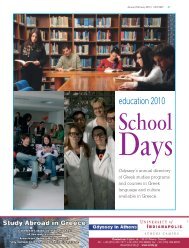Food Preservation & Sensory Analysis
Food Preservation & Sensory Analysis
Food Preservation & Sensory Analysis
- No tags were found...
You also want an ePaper? Increase the reach of your titles
YUMPU automatically turns print PDFs into web optimized ePapers that Google loves.
Module Title<br />
<strong>Food</strong> <strong>Preservation</strong> & <strong>Sensory</strong><br />
<strong>Analysis</strong><br />
Module<br />
Number<br />
JACS Subject Code(s)<br />
and % of each subject<br />
STF 4005 D632 3<br />
ASC<br />
Category(ies)<br />
Level (4-6 u/g;<br />
7 p/g; 8 doctorate)<br />
Credits<br />
ECTS<br />
Credit<br />
Module<br />
Value<br />
% Taught in<br />
Welsh<br />
Module Type<br />
4 10 5 1 0% Standard Taught module<br />
Teaching Period<br />
Terms 2 & 3<br />
Pre-requisites<br />
None<br />
Module Leader<br />
School(s)<br />
Campus<br />
Dr Ian Ashton CSHS Llandaff<br />
Assessment Methods<br />
Assessment Type<br />
Duration/Length of<br />
Assessment Type<br />
Weighting of<br />
Assessment<br />
Approximate Date of<br />
Submission<br />
Examination 2 hours 80%<br />
Practical reports 1500 20%<br />
Aim(s)<br />
To enable the student to gain an understanding of the principles and practices of food<br />
processing & preservation techniques, sensory analysis, and how these relate to distribution,<br />
storage, quality and safety of food.
Learning Outcomes<br />
On completion of the module, the student should be able to:<br />
Identify the full range of preservation techniques used in the food industry.<br />
Describe the characteristics of the major techniques and examine their effect on shelf life and food<br />
quality.<br />
Describe the types of sensory analysis test available and their uses in the food industry.<br />
Demonstrate a basic understanding of the psychological factors that can affect taste panels and how<br />
these factors can be minimised.<br />
Describe the basic physiological mechanisms of the senses.<br />
Carry out, analyse and comment on the results of sensory analysis panels.<br />
Evaluate a wide range of packaging materials.<br />
Use a range of food processing/preservation equipment and demonstrate practical skills and<br />
techniques.<br />
Evaluate experimental results and compare data with manufacturers’ labels and the literature.<br />
Learning and Teaching Delivery Methods<br />
Lectures:<br />
Practical / tutorials:<br />
24 hours<br />
12 hours<br />
Indicative Content<br />
Techniques for preservation: Pasteurisation, Sterilisation (UHT and canning), Dehydration, Smoking of
foods, Chemical preservation (e.g. use of sugar, salt and other chemicals), Chilling, Freezing, Irradiation<br />
Functions, requirements, advantages and disadvantages of packaging materials.<br />
Modified Atmosphere Packaging.<br />
Introduction to sensory evaluation its theory, methods and analysis.<br />
Recommended Reading & Required Reading<br />
There is no single required text for this module the following are suitable:<br />
Beckett, S.T. (1996) Physico-Chemical Aspects of <strong>Food</strong> Processing. Blackie Academic and<br />
Professional. London<br />
Brennan, J.G. (1994) Dehydration : A Dictionary and Guide. Blackie Academic and Professional.<br />
London<br />
Gaman, P.M. & Sherrington, K.B. (1996) The Science of <strong>Food</strong>. 4 th edition. Butterworth-Heinemann.<br />
Oxford<br />
Gould, G.W. (1994) New Methods of <strong>Food</strong> <strong>Preservation</strong>. Blackie Academic and Professional. London<br />
Heldman, D.R. & Hartel, R.W. (1997) Principles of <strong>Food</strong> Processing. Chapman and Hall. London<br />
Kemp S.E., Hollowood, T. & Hort, J. (2009) <strong>Sensory</strong> Evaluation. A Practical handbook.<br />
Chichester. Wiley-Blackwell<br />
Kyzlink, V. (1990) Principles of <strong>Food</strong> <strong>Preservation</strong>. Elsevier. New York<br />
Meilgaard M.C., Civille G.V. & Carr T (2006) <strong>Sensory</strong> Evaluation Techniques. 4 th Edition. CRC Press<br />
Inc; Cambridge, UK.<br />
Moskowitz, H.R., Beckley J.H & Resurreccion A.V.A (2005) <strong>Sensory</strong> and Consumer Research in <strong>Food</strong><br />
Product Design and Development. Institute of <strong>Food</strong> Technologists. USA.<br />
Paine, F.A. (1992) A Handbook of <strong>Food</strong> Packaging. 2 nd edition. Blackie Academic and Professional.<br />
London<br />
<strong>Food</strong> Standard’s Agency (2004) McCance and Widdowson’s The Composition of <strong>Food</strong>s. 6th<br />
Summary Edition. Cambridge. Royal Society of Chemistry.<br />
Poste, L. M. et al (1991) Laboratory Methods for the <strong>Sensory</strong> Evaluation of <strong>Food</strong>. Ministry of Supplies &<br />
Services, Ottawa Canada.<br />
Proudlove, R.K. (1992) The Science and Technology of <strong>Food</strong>s. 3 rd edition. Forbes, London.<br />
Rees, J.A.G. (1991) Processing and Packaging of Heat Preserved <strong>Food</strong>s. Blackie Academic and<br />
Professional. London
Royal Society of Chemistry (Including updated supplements). Cambridge<br />
Sidel J.L & Stone H (2004) <strong>Sensory</strong> Evaluation Practices. Academic press Inc. USA.<br />
Wilkinson, V.M. (1996) <strong>Food</strong> Irradiation : A Reference Guide. Butterworth-Heinemann. Oxford<br />
Access to Specialist Requirements<br />
<strong>Food</strong> processing and sensory analysis laboratories
















